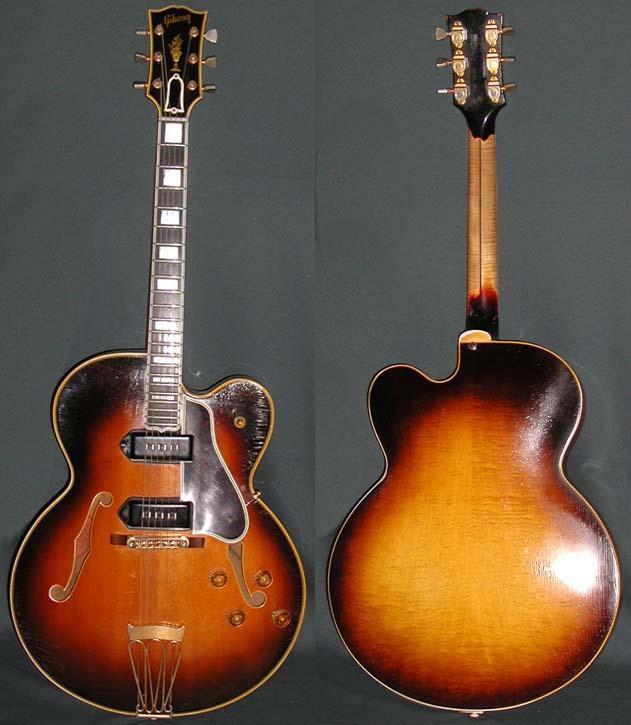| 1955 Gibson Byrdland |
At the time Gibson's president, Ted McCarty, sought opinions and ideas about new products. So in 1955, in collaboration with two of the best Nashville guitars on the scene, Billy Byrd and Hank Garland, Gibson developed the Byrdland guitar.
The Byrdland was the first of Gibson's Thinline series. Many guitarists did not desire the bulk of a traditional archtop guitar such as Gibson's L-5 CES, one of Gibson’s top models. The Byrdland was built with its overall depth of 2¼ inches which,was over one inch shallower the Gibson's L-5 CES model.
It was later during the design process, Byrd and Garland specified a shorter scale neck.which would help facilitate intricate single-note patterns and unusual stretched chord voicings.
 |
| Billy Byrd |
The original instruments were to come with twin Gibson P90 single coil pickups. Although Hank ordered his with a single P90 and a Charlie Christian pickup in the neck position.
 |
| 1957 Byrdland |
This guitar was designed with jazz players in mind. It featured the same 17” wide, 21” long spruce top and body as was on the single cutaway L-5 CES, but the body was shallow. In comparison, the Byrdlands body was only 2 1/4” deep as opposed to the full 3 3/8” body of an L-5.
 |
| 1957 Byrdland Gary's Guitars |
The production models were equipped with Alnico V pickups. One interesting feature of this guitar is the fact that the two pickups are spaced closer together, because of the shorter scale and the 22 fret neck.
This gives the the Byrdland it’s distinctive sound. In later years the Alnicos were replaced with humbucking pickups.
The headstock and the neck were both bound. The ebony fretboard came with block mother-of-pearl position markers which started at the first fret. The headstock featured the traditional Gibson flower pot inlay.
The Byrdland came with a fancy gold-plated trapeze tail piece that was engraved with Byrdland and the rosewood bridge with topped with a Gibson tune-o-matic saddle. The body was bound as were the guitars F holes.
 |
| Hank's #2 |
By 1956, Gibson sold 60 units, which was more than the combined sales of L-5’s and Super 400’s. Electric guitarists seemed to appreciate the feel of the narrow body.
The number 3 Byrdland was the guitar that Hank played at the famous Elvis concert in Tuepelo Mississippi in 1957. This was during a period when Scotty Moore and Bill Black had quit the band.
 |
| Hank's number 3 |
Hanks number three was given back to Gibson in 1957 and was supposed to be archived, however someone mistakenly sold it to a music store in Chattanooga Tennessee. A music teacher there purchased it and had it autographed by Hank Garland.
 |
| 1956 Gibson ES-350T |
From 1955 to 1960, Gibson made the Byrdland with a Venetian, or rounded, cutaway.
 |
| 1961 Byrdland |
From 1961 to 1968, it used the sharp, pointed, Florentine cutaway.
It returned to the Venetian in 1969. The model was in production from 1955 through 1969.
 |
| 1978 Byrdland |
Gibson reintroduced it as a limited run in 1977, 1978 and 1992.
In the late 1960s, guitarist Ted Nugent began using a Byrdland, which was unusual considering Nugent's style of music.However, in an interview Nugent states that he first saw Detroit guitarist Jimmy McCarty playing a Byrdland back in the early 1960's.
 |
| Nugent's Great White Buffalo Model |
 |
| 2015 Gibson Custom Byrdland |
When the instrument was first introduced in the Gibson Guitar catalog, the famous jazz club, Birdland, filed a lawsuit against Gibson over the name. The court dismissed the suit when Gibson showed that the name was made up from the names of two people.
Click on the links for further information.
©UniqueGuitar Publications (text only)






1961/62- 1969 One piece laminated back replaced two piece carved back.
ReplyDeleteMid 1962: Three piece maple neck replaced the two piece maple neck.
ReplyDeleteThanks for the updates as always Anonymous.
ReplyDeletePressed top,rosewood fingerboard, cherry guitar was signed much later by Hank, Blonde with Charlie Christian still owned by Hanks brother Billie was used in "Crazy" Movie about Hank
ReplyDeleteFyi Hank also played bass on many tracks and was supporting Elvis in Tupelo because he was moving away from Rockabilly and old band was let go, they didnt quit.
ReplyDelete